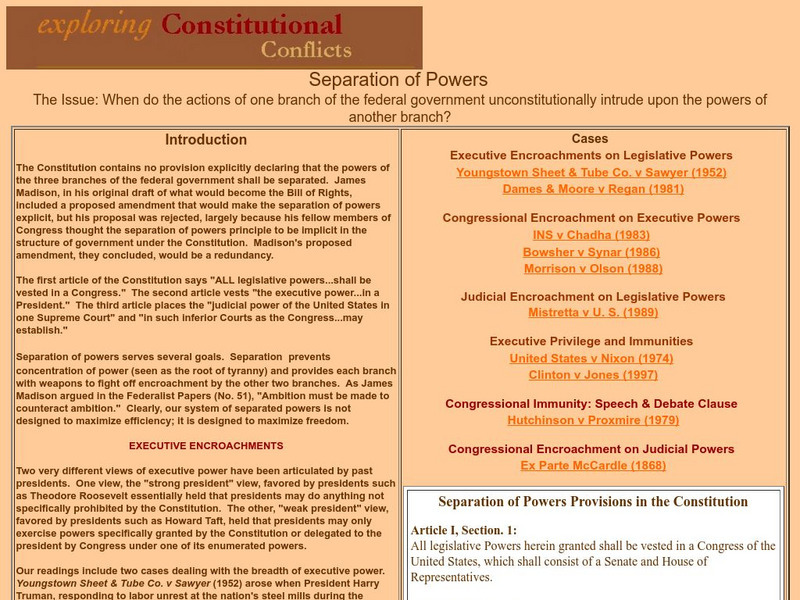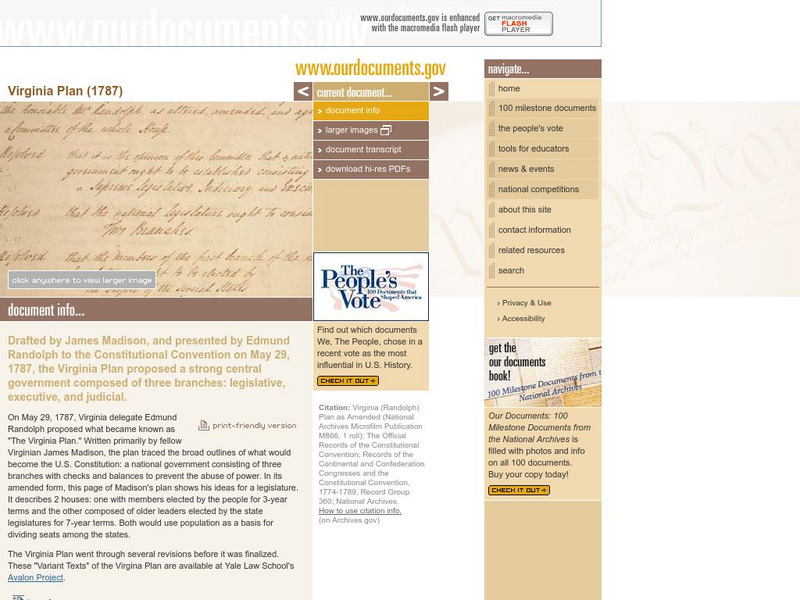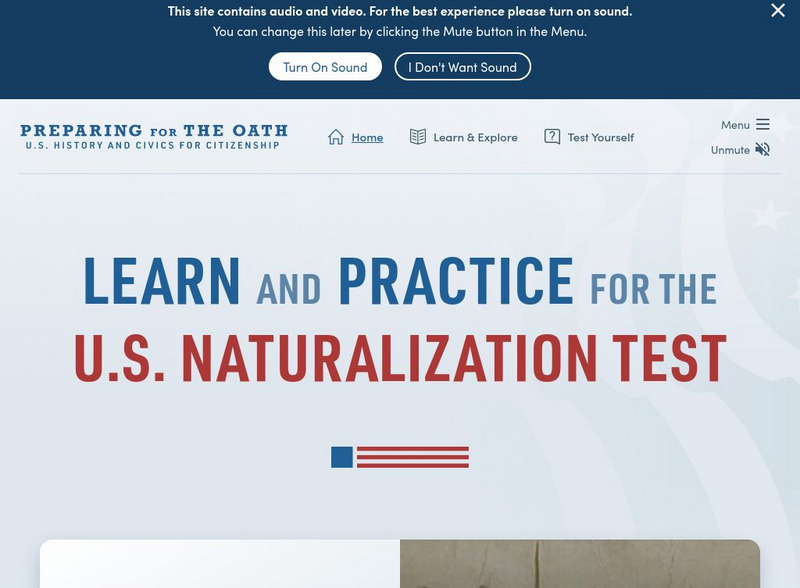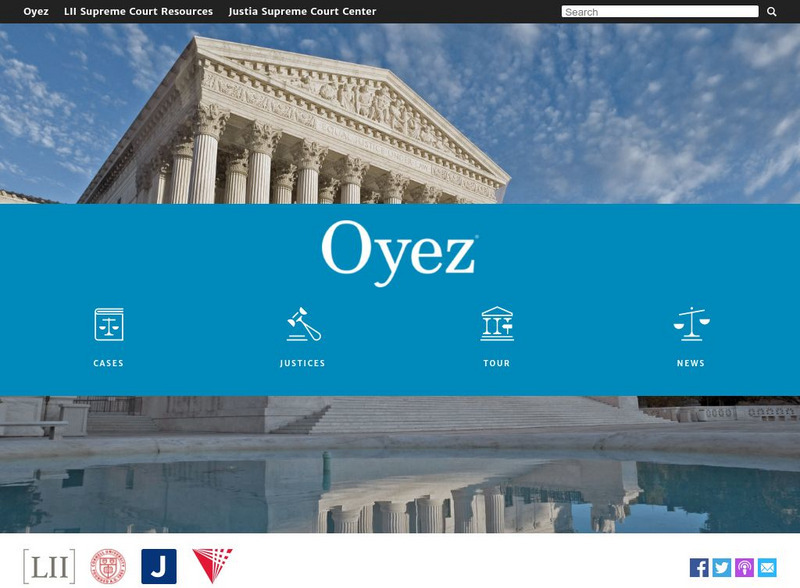Curated OER
Civics: State Vs. Rowe
Learners examine the case of State vs. Rowe to discover the duties of the three branches of government. They explore the concepts of separation of powers and checks and balances to assess how they apply to an actual situation.
Curated OER
Advice And Consent - the Senate Considers the President's Supreme Court Nominations
Learners study the process and questioning for selecting a Supreme Court Justice. They examine how the decisions of the Supreme Court effect the lives of citizens. They complete worksheets as they study the material.
Curated OER
Claim Your Power
Fourth graders analyze the branches of the Texas government and identify its powers and characteristics. The separation of powers and checks and balances are identified.
Curated OER
Constitutional Issues: Separation of Powers
Students discribe the principle and the history of separation of powers.
Harry S. Truman Library and Museum
Harry S. Truman Library & Museum: Three Branches of Government
Interactive teaching unit for Grades 5-8 that helps to explain the three branches of government and the the balance of power. Topics covered include balance of government, how a bill becomes a law, the amendment process, the Legislative...
University of Chicago
The Founders' Constitution: Federal v. Consolidated Government: Virginia Plan
The original text of The Virginia Plan presented at the Constitutional Convention. Discusses federal versus consolidated government.
University of Missouri
Exploring Constitutional Conflicts: Separation of Powers
When do the actions of one branch of the federal government unconstitutionally intrude upon the powers of another branch? This article surveys the history of this question in historic Supreme Court cases.
US National Archives
Our Documents: Virginia Plan (1787)
Read the complete text of the Virginia Plan that proposed a strong central government consisting of three branches. You can also view images of the original drafts.
iCivics
I Civics: Three Branches
A web quest looking at how a law gets passed as it moves through the three branches of the United States government: executive, legislative, and judicial. Each page has a question to answer, and a link to a site with information specific...
Tom Richey
Tom Richey: Constitutional Underpinnings of u.s. Government
The first unit of an online course on AP US Government and Politics. It explores key concepts of American government, including constitutional government, republicanism, separation of powers, checks and balances, federalism, construction...
National Cable Satellite Corporation
C Span Classroom: Interactive Supreme Court Timeline Case Study
In this interactive lesson, students will identify important Supreme Court cases, evaluate their decisions, explain the precedents they established, and analyze their importance to our society today.
US National Archives
National Archives: Teaching Six Big Ideas in the Constitution
The Constitution can be broken down into 6 main themes: Limited Government, Federalism, Republicanism, Separation of Powers, Checks and Balances, and Popular Sovereignty. Students will study background on the Founding Fathers and use...
University of North Carolina
University of North Carolina: Constitution 101 [Pdf]
Provides a good basic introduction to the Constitution. Explains the founding principles, checks and balances, the rationale for it, the accomplishments of the Constitutional Convention, the debate and ratification, the structure of the...
The Dirksen Congressional Center
Congress Link: Lesson Plans
The Dirksen Congressional Center provides abundant lesson plans on all aspects of the US Congress and the US Constitution. All lessons contain time frames, objectives, and links to material, and are built around Bloom's taxonomy.
Smithsonian Institution
National Museum of American History: Preparing for the Oath: u.s. History and Civics for Citizenship
This site from the National Museum of American History, part of the Smithsonian Institution, is a great site for citizens and those learning to become citizens alike. Review the fifteen themes that deal with U.S. history and civics,...
C-SPAN
C Span Classroom: Teaching About Gridlock
Learning module and lesson plan with C-SPAN video resources and related articles for students to examine and deliberate on whether or not the President should exercise executive powers during times of Congressional gridlock.
Illinois Institute of Technology
Oyez Project
The OYEZ Project is a vast multimedia relational database on the U.S. Supreme Court that contains abstracts for all leading constitutional decisions of the Court, authoritative oral arguments in streamed media format, and a 360-degree...
CPALMS
Florida State University Cpalms: Florida Students: Enlightenment Ideas and the Founding Fathers
A tutorial that looks at the ideas from the Enlightenment that influenced the Founding Fathers, particularly those of John Locke and Montesquieu. A PDF file of the tutorial is available.
Other
The Federalist Papers:convention, Constitution,& Debates
A clickable index of the 85 Federalist Papers. The text of each letter (paper) sent to New York newspapers in 1787 and 1788 is easily accessed.
OpenStax
Open Stax: Debating Democracy
By the end of this section of a chapter on "Creating Republican Governments," students will be able to explain the development of state constitutions, describe the features of the Articles of Confederation, and analyze the causes and...
US Senate
The u.s. Senate: The Senate and the United States Constitution
This site from the United States Senate provides information about the evolution of the Senate as the Constitution was being written by the Constitutional Congress.
ClassFlow
Class Flow: Constitution
[Free Registration/Login Required] This flipchart is an in depth Activote questionnaire relating to our Constitution. Students should understand the basic concepts of the Constitution, checks and balances, separation of powers, and...
Annenberg Foundation
Annenberg Learner: Democracy in America: The Constitution: Fixed or Flexible?
This unit explores the timeless qualities of The U.S. Constitution, the opportunities to amend it, and how it is a pillar of the American identity, through these activities, videos, and outside resources.
US National Archives
National Archives: The Constitution in Action: Article Ii
This activity can be used during a unit on the U.S. Constitution. Students will analyze the Senate Journal of the First Congress and identify how the document demonstrates content contained within Article II of the Constitution in...


















